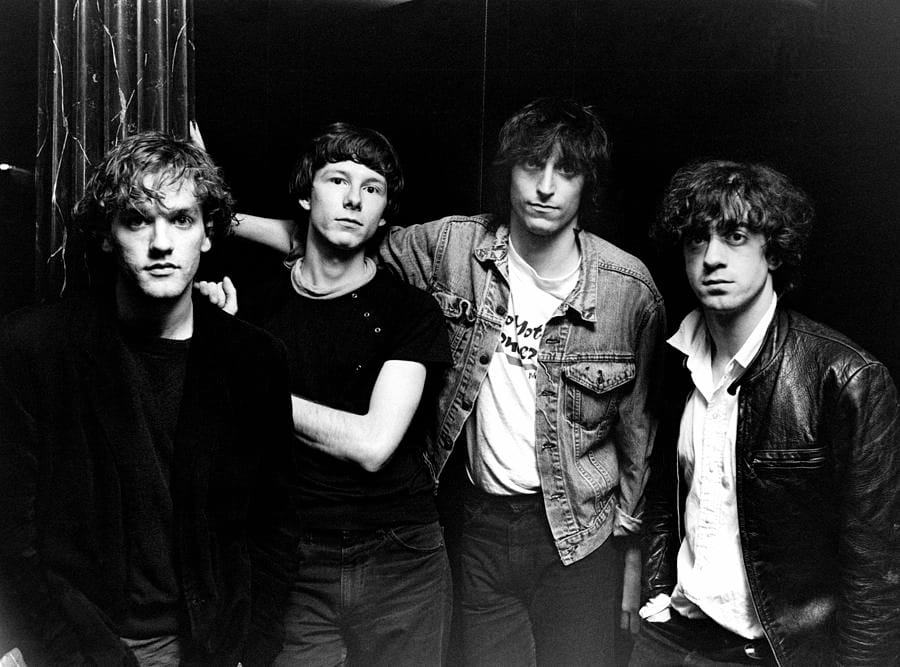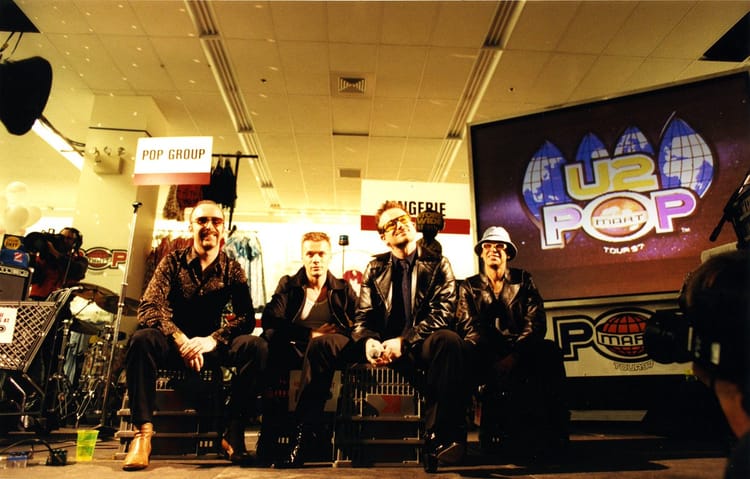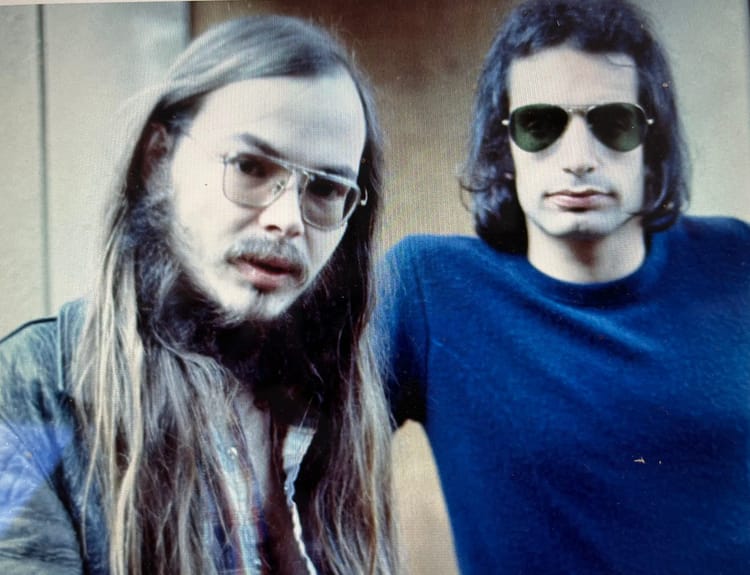R.E.M., pt. 1: Anthony's Album Guide

My handy dandy profoundly subjective numerical rating scheme is decoded here. Part 2 is here.
Chronic Town EP (1982) 9
Murmur (1983) 8
Reckoning (1984) 9
Fables Of The Reconstruction (1985) 8
Life’s Rich Pageant (1986) 8
Dead Letter Office (1987) 8
Document (1987) 8
Eponymous (1988) 6
The Best Of R.E.M. (1991) 6
And I Feel Fine…: The Best Of The I.R.S. Years 1982-1987 (2006) 5
Talk about the right people, in the right place, at the right time. An art student who sang but didn’t like to think too hard about music meets a record store clerk who plays guitar and lives to think too hard about music. A geek bassist meets a freak drummer, their high school hallway clashes forgiven once they realized each other’s skills. The foursome get together at the University of Georgia in Athens, where hometown heroes the B-52’s set a precedent that party bands could - nay, should - be unapologetically eccentric. Within a week of their first concert in 1980, their future lawyer and manager Bertis Downs tells them they’ll be bigger than The Beatles. While Downs was merely a law student at the time, his reaction was indicative of the environment and enthusiasm that gave the quartet faith in their idiosyncratic make-up and mission, presenting a unified front as they gradually went from local favorites to underground stars to multiplatinum in just over a decade.
Despite their immediate popularity on what passed for a Southeastern new wave circuit (original manager Jefferson Holt moving down from Chapel Hill, NC to work with them), the band was in no rush to become a national concern, working out their songbook at shows and waiting a year after forming to release their first indie single, “Radio Free Europe.” More than half the first pressing was shipped out as promos, which paid off big-time. The band got love in the New York Times and their 1982 EP Chronic Town came out on I.R.S., an indie label with distribution major enough to get The Go-Go’s to number one the year before.
Fun fact! I met a fellow college radio DJ when he heard me playing the riff to "Wolves, Lower" in my dorm room and knocked on my door.
But what was the sound that had cool kid and critic alike so excited? (Chronic Town was the #2 EP in the Pazz’n’Jop poll that year - right behind T-Bone Burnett!) Like Aerosmith before and Pavement after, R.E.M. provided an American twist on British innovations to American rock. While their stage moves aped Gang Of Four (compare bassist Mike Mills in early footage to Dave Allen on The Old Grey Whistle Test) and drummer Bill Berry kept the beat dance-oriented, Peter Buck arpeggiated on his Rickenbacker like a Roger McGuinn wanna-be on uppers, and Michael Stipe drawled shyly underneath shaggy locks when he wasn’t hollering “down there they’re rounding a posse to ride” or some such obtuse fragment.
Even if one was religiously reading their interviews, always a terrific source of musical recommendations and indie-minded encouragement, it could take years to recognize how important each member was to their sound. Berry and Mills were heavily involved in the songwriting and studio arrangements, Buck delighted the band’s sound could evolve despite him barely knowing how to play even one instrument. Looking back at their discography, one could generalize that Mills made sure songs were beautiful, Berry made sure they held your attention, and Buck made sure they were cool. Then Stipe added his coy magic, which was usually beautiful, commanding and cool, if not particularly coherent.
As gestative as Chronic Town feels today, R.E.M.’s core virtues were already in place. The music was weird but warm, playing with studio effects without trying to spook or intimidate. These were young musicians in love with “Death Disco” but not in love with death, a band of cute American boys reveling in the beauty and possibility of post-punk, with no desire to promote anything else. Not even their mugs! You’d actually have to see them live or read a rock zine to find out they were cute, as album artwork and song titles were pointedly obscure. Though this EP of jumpy jangle was only meant to impress Pylon (and maybe some Police) fans, it shimmers with unassuming, unique authority.
The video for "Radio Free Europe," reportedly requested to exist by MTV, though probably with less moss than the final product included.
Their first full-length, Murmur, is considered a monument by many, but I find it ironically transitional: tender, arresting ballads you’d never find on Rough Trade imports, and flimsy filler that would never have made it onto Chronic Town. “Perfect Circle,” with the rhythm section on dueling pianos (possibly for the first and last time in the history of rock), reveals Michael Stipe’s gift for bittersweet ambiguity; it played before my wedding as an oblique tribute to my recently departed mother and the past in general (the band doesn’t even agree on what actually inspired it). “We Walk” reveals the band didn’t just collect British 7-inches, for better or worse, the instrumental trio slipping into an annoying rockabilly lope while Stipe repeatedly yells “take oasis” (the climactic echoes of a distant pool game are pretty Swell Maps, though). Both sides of the ’81 single were re-recorded, and might be the respective rock peaks on each side of the record without necessarily improving on the originals. I can only imagine how Murmur sounded in 1983, when Rolling Stone was putting it above Thriller and Synchronicity on their year-end list, but I wouldn’t hear it until amassing the discography on cassette & CD in the early ‘90s. From that vantage, Murmur is merely mostly wonderful.
The same career canniness that made them wait three years to record their debut album inspired them to bash out the follow-up in a week with the same producers in the same studio, releasing it almost exactly a year after Murmur, wishing to get any sophomore slump behind them quickly. But rather than rehashing Murmur, Reckoning captures the band in full bloom, shaking off any “post-punk”/“new wave” debates and subtly making their claim as the premiere American underground rock band of the time (that subtlety was rather wise, with once and future openers Husker Du, The Minutemen and The Replacements releasing Big Statements the same year). Mills & Berry’s southern roots come out in the strong grooves, helping their harmonies and Buck’s riffs sound effortless and invigorating even compared to those on Chronic Town. Each side features one winsome piano-tinged plaint and one relative trudge, all surrounded by rockers that ape the rushing beauty of Aerosmith circa Rocks without the macho horndogging. Reckoning is a road album that sounds like a gorgeous day at a park, sun flickering through the leaves. It’s rare to here something so lovely and so lively.
There are two reasons to enjoy "Can't Get There From Here": Stockholm syndrome or a profound level of ironic perversity. It's surprising I'm guilty of neither.
Sophomore slump avoided, the band felt assured enough to go international, ditching like-minded producers Mitch Easter & Don Dixon in North Carolina for folk-rock eminence Joe Boyd in London. Any hipsters grumbling this band was merely art-rock in indie clothing must have been tickled by the harmonics and strings on “Feeling Gravitys Pull,” the anguished opener of Fables Of The Reconstruction, arguably the most awkward and dangerously close to negligible album of their first (and maybe second) act. No R.E.M. fan could deny the familiar appeal of “Driver 8,” “Green Grow The Rushes” or “Life And How To Live It,” but plenty could do without the chicken-scratch funk exercise “Can’t Get There From Here” or the glum portense that drags down the B side. If the band wasn’t so good at being R.E.M., Fables could be mistaken for a band of obnoxious lit majors who wished they were R.E.M., waving Southern Gothic signifiers without actually saying anything.
Eager to move past this gloomy year abroad, the band plowed forward and got back to rockin’ with John Cougar Mellencamp’s producer Don Gehman in Belmont, Indiana (just down the road from IU and Bloomington). While the instrumental trio delighted at being back in an American college town and playing with the latest in AOR technology, Gehman did Stipe the belated indignity of asking what the hell he was singing about. I don’t think he managed to get a straight answer, judging by the folk chantey that goes “Swan swan hummingbird/hurrah, we are all free now…girl and dog, he bore his cross.” But Gehman did get Stipe to enunciate more often than not on Life's Rich Pageant, even doing their landlord Cougar proud with overt references to pollution and political injustice. The barnstorming banjo-rocker “I Believe” manages to have its eccentricity (“I believe in coyotes/ and time as an abstract”) and transcend it too (“I believe my humor’s wearing thin/ and change is what I believe in”). That chantey - blessedly shorter than anything on Fables - is followed by a quote from a Godzilla pull-string doll and a jubilant cover of “Superman,” a forgotten b-side by one-hit-wonders the Clique that has since been performed on Glee. Also somehow under three minutes is “Fall On Me,” an ironically uptempo agnostic prayer about global oppression & cultural indifference to environmental disaster. Sometimes I think it's the band's biggest accomplishment, and maybe the saddest song I've ever heard (at least in the short-form competition). A dizzy, defiant acknowledgment of the contemporary world, Life’s Rich Pageant was the first R.E.M. album to go Gold.
How fast did R.E.M. work in the '80s? Here they are performing "Fall On Me" on German TV almost a year before release, Michael not having written a verse lyric.
I.R.S. celebrated the band’s blooming fanbase by releasing Dead Letter Office, a B-side collection with typically wry commentary from Peter Buck (later seen promoting Oscar Wilde in a legendary READ For America’s Libraries poster). Along with the metal joke “Burning Hell” and a charming Aerosmith cover are lightweight jangles like “Burning Down” and three monstrously mediocre covers of the Velvet Underground. The LP ends with the band falling over itself trying to get through Roger Miller’s “King Of The Road,” but the CD follows that with the entirety of Chronic Town. Owning the latter is likely a reason I find the preceding whimsy & ephemera worth keeping around, though there’s also “Voice Of Harold,” where Stipe fights writer’s block by reading the liners for a gospel album over the instrumental track of Reckoning’s “7 Chinese Brothers.” And “Burning Hell” truly is hilarious. Those shrieks!
Don Gehman suggested the band work with dBs producer Scott Litt, who before that was Carly Simon’s engineer and secret lover. Oddly enough, this was the perfect person to help take the band into the stratosphere, encouraging their crossover fantasies while unfazed by their left-field impulses. Document doubles down on Pageant’s arena rock swagger, the resulting bombastic anti-Reaganite bubblegum epitomized by a jaw-droppingly heretical cover of “Strange” by art-punk icons Wire, turning a passing “duh-doo-doo duh-doo-doo” from the original into an inescapable earworm, before adding a guitar solo and handclaps. “It’s The End Of The World (As We Know It)” is a blistering update of “Too Much Monkey Business” and “Subterranean Homesick Blues,” and “The One I Love” was so downright erotic (Mike Mills - Mike Mills! - screaming “fire coming down over the earth”!) that pop radio finally relented, giving the boys a Top 10 hit after previously peaking at 78. The band has noted many people miss the song is a real hatefuck, but frankly I’m amazed R.E.M. were doing any kind of fucking on the radio at all, and only five years after “Carnival Of Sorts (Box Cars).” But despite this staggering pace and degree of evolution, they’d managed to stay beautiful, commanding and cool throughout.
R.E.M. doing "The One I Love" in France, Michael Stipe somehow both shy and shirtless.
Their I.R.S. contract fulfilled, every label on Earth - including I.R.S. - was eager to sign them up for another five albums. The band eventually went with Warner Bros, the label that had overwhelmingly done right by Neil Young. (Missing out on R.E.M. was a big reason Geffen, the label who’d done wrong by Neil Young, made sure to give Sonic Youth so much love.) Less than a month before their Warners’ debut, Green, I.R.S. put out Eponymous, a best-of that featured a few novelties (the original “Radio Free Europe”! “Finest Worksong” with horns!) but still lacks utility for a fan with the five albums represented. The Best Of R.E.M., originally a European-only release meant to mooch off Warners' second R.E.M. album, has a longer, better tracklisting than Eponymous, but no novelties whatsoever.
A double-disc named …And I Feel Fine was released in 2006, when the band needed to exploit their past more than the past needed to exploit them. Disc 1 is a pleasant jumble of tracks, and Disc 2 brackets outtakes overwhelmingly unworthy of Eponymous or Dead Letter Office with four album tracks (the best is “Bad Day,” an ironically depressing revelation that one of their best singles of the ‘00s could have come out two decades earlier). I could walk out of Amoeba Records with the five I.R.S. albums (and maybe even Dead Letter Office) on used CD for about ten bucks, so there’s certainly no economic reason to bother with these compilations today.
Up next in Part 2: the band goes major and multiplatinum. And I discover them on MTV!
(Reckoning and Document are respectively at 113 and 281 on My Top 300 Favorite Albums of All Time. I'm telling you this because I've found people are more inclined to discuss and share reviews if there's a quantitative element at the top or bottom they can easily debate. Prove me right!)
All comments and queries can be hurled to anthonyisright at gmail dot com.




